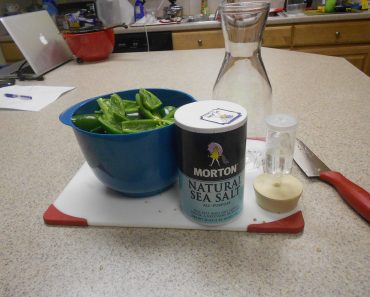
When I was younger I could not tolerate hot food, but as I age, I find myself enjoying spicy food.
Couple that with my DIY gene, I really enjoy making my own hot sauce; it is not hard and makes a quality sauce for little expense.
This recipe works with any hot pepper, and I usually use a blend of jalapeno and habanero.
Making a pepper mash is different than making hot sauce – you make the sauce from the mash.
The pepper mash is fermented to mellow the flavor of the peppers and really ads to the quality. Tabasco sauce, for instance, is fermented for three years, but I find after 6 months you really don’t get that much more quality.
Since we are letting the peppers ferment, we are going to be adding salt to suppress bad bacteria and mold.
What You Need
The first thing you are going to need is a glass jar or pottery crock, size matters as you only can fill it about ¾ full so it won’t overflow as it ferments. You want a straight sided container so you can use a weighted plate to keep the peppers under the liquid (this prevents mold).
Since I am only making sauce for myself, I actually us a glass juice carafe and a large rubber bung and airlock instead.
As you size your jug, realize that 1 pound of peppers will produce a little less than a pint of pepper mash.
As you pick your peppers, get the largest, plumpest fully ripe peppers from the garden or market. Fully ripe peppers have a more sugar content, so that will help with fermentation.
I remove the seeds from my peppers, but that is a personal choice. Contrary to popular opinion, the seeds don’t add much heat. The real heat comes from the connecting veins that attach the seeds to the pepper walls.
If you are dislike getting burned by peppers, I have a great tip to help wash off the oleo-resin capsicum inside the hot pepper.
How to Make the Pepper Mash
Wash the peppers and dry them with a towel or paper towel before processing them.
Remove and discard the stems.
Add 1 Tablespoon of salt per pint of mash
Process the peppers in a blender.
Pour one Tablespoon sea salt per pound of peppers in a blender and process them on high speed till they become puree (mash), no more than a minute at the absolute most, typically only 15 to 30 seconds
You may add other vegetables, herbs, and spices into the blender and puree it along with the peppers mash, so long as you maintain the salt ratio to weight of vegetable matter. Anything you add will dramatically affect the taste of the finished product, (I add sweet peppers)
Pour the mash into the fermentation jar or crock. You need to keep air away from the mash, but if you seal it airtight it will explode. If you are using a straight sided crock, set an upside down plate inside the crock so that it can move up and down the crock, weigh it down with a ziplock bag full of water. Since I use a large juice carafe, I simply stick in a large rubber bung fitted with a airlock for making wine.
In one week, the pepper mash will start bubbling vigorously as a result of fermentation in which the bacteria will produce acetic acid and any sugars will produce alcohol and carbon dioxide gas. The gas bubbles will cause the pulp in the mash to rise, leaving the liquid and some solids on the bottom.
In another week or two, the fermentation should stop producing bubbles.
You may use the mash as soon as fermentation has finished. I let it age in a dark closet for about 6 months though.
You can use this mash directly on food. However it’s a simple process to turn it into a sauce. I will save that for another post….








